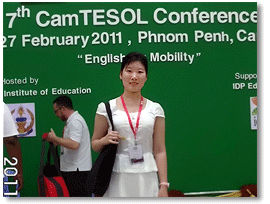| |
|
|
||
输入关键词,搜索本站更多内容 |
||

| 作者:广西大学行健文理学院/李晨辛 来源:本站征稿 本站编辑发布 | ||
 【本站按】这里发表的是广西大学行健文理学院英语专业学生李晨辛同学的英语论文。她于大二时(2009年)参加该校外籍教师Igor Smerdov指导的英语学术研究小组,并开始着手撰写论文。2011年初,李晨辛同学获邀参加了泰国第31届TESOL会议和柬埔寨第7届TESOL会议。作为一名尚未走出大学校门的学生就能有这样的研究意识,并能用英语撰写学术论文,且受邀参加国际性学术交流会议,这是值得褒奖和宣扬的。同时,她所研究的课题(个案研究:中国学生在合作学习框架“分步学习-总结指导教学法”中英语写作的表现),对国内英语教师也是有一定参考价值的;对喜欢英语写作的学子也可供借鉴。这里我们摘要发表李晨辛同学的这篇论文。为了方便阅读,论文的摘要部分以汉英双语发布(做较详尽的翻译和说明)。论文主体部分则发布英文写作原文。
【本站按】这里发表的是广西大学行健文理学院英语专业学生李晨辛同学的英语论文。她于大二时(2009年)参加该校外籍教师Igor Smerdov指导的英语学术研究小组,并开始着手撰写论文。2011年初,李晨辛同学获邀参加了泰国第31届TESOL会议和柬埔寨第7届TESOL会议。作为一名尚未走出大学校门的学生就能有这样的研究意识,并能用英语撰写学术论文,且受邀参加国际性学术交流会议,这是值得褒奖和宣扬的。同时,她所研究的课题(个案研究:中国学生在合作学习框架“分步学习-总结指导教学法”中英语写作的表现),对国内英语教师也是有一定参考价值的;对喜欢英语写作的学子也可供借鉴。这里我们摘要发表李晨辛同学的这篇论文。为了方便阅读,论文的摘要部分以汉英双语发布(做较详尽的翻译和说明)。论文主体部分则发布英文写作原文。
【关键词】 英语写作 个体表现 分步学习-总结指导教学法 互助学习
【摘要与简介】本论文以三个案例研究为基础,数据来自3个大一学生(包括作者本人)在大一学年所写作文(每个作文话题包括3篇草稿和1篇定稿)以及通过2份问卷调查所获得的数据对比。
主要内容:个体学生在“分步学习-总结指导教学法” 这一教学框架下,关于英语写作的进步和停滞的评估。该论文还就目前中国国情以及传统的教学法与论文中描述的这一教学法进行了对比,目的在于更好地了解、帮助学生解决在写作中遇到的问题,从而改善教学方式,提高教学质量。
目前国外已有许多关于“分步学习-总结指导教学法”的研究,可理解为“互助学习法” 和“结果反馈指导法”相结合的教学法,通常也与课上交流、合作学习等教学法一同使用。这一教学法在国内还未普及,究其原因应当在于“分步学习-总结指导教学法”较适用于小班教学,但这与我国班级人数众多的国情不符。
本文中“分步学习-总结指导教学法”的介绍以外教Igor Smerdov的实际教学为基础。其重点在于班级讨论和收集材料,第一次草稿和第二次草稿,同学间交流和改善,定稿和教师评改。在四周时间内,就某一话题,学生需写好一份纲要,两篇200字的草稿,以及打印好的定稿。在第一周收集材料写成提纲;第二周,老师会抽取学生板书提纲并由其他同学提出建议和修改,然后完成第一篇草稿。接下来的两周内,学生以同样方法交流、修改作文。最后,将多次修改后的作文打印并交由老师评改。课上,老师会帮助学生找出语法、中式英语等错误,给出写作要求。最终,学生会得到同学和老师两方面的修正,而成绩要根据学生在这四周课上的综合表现(如积极发言,给出意见等)给出。
不同与传统教学,“分步学习-总结指导教学法”是以学生为中心的教学法,学生可在课上通过交流、讨论相互学习,不仅可使课堂保持活跃、提高学生积极性,也保证了教学质量和学习成效。
“分步学习”指学生从写提纲到定稿的过程中以交流、互助等手段分步学习的方式;
"总结指导教学法”指教师对最后一篇习作给出的批改和指导,学生写的所有稿件作为整体体现出进步。
Abstract:(摘要)My action research pioneers the measurement of individual writing progress within a particular popular teaching framework in China––the Process-Produce Approach. The experiment timeline: the freshman year at college. The results of the study help teachers advance writing instruction methods in Asia and help students learn writing effectively.
The results of my qualitative/quantitative analysis of the essay database (21 outlines, 63 drafts and 21finals) are on different levels from the discourse analysis to grammar. Also, the results issued from a questionnaire answered by students identify their main progress and problems.
Progress made: Students learned to express ideas in the English (Western) way reducing the L1 influence, e.g. avoided rhetorical questions in the first paragraph; started supporting ideas by giving persuasive reasons and particular examples related to real life situations; stated topic sentences in the first paragraph and put forward the main idea firstly; concluded the essays with extended ideas expressed in synonyms to key words; learned many phrases from peer-editing and applied them into others essays; figured out writing argument essay and narration essay in a well-structured English writing and made paragraphs coherent; improved self-expression by learning and using proper words to express meanings accurately, e.g. enlarge mind—broaden horizons; linked self thought to readers and convinced readers, e.g. wrote explanatory notes for readers which had no idea of Chinese background; reduced grammar mistakes, especially on Subject-Verb Agreement and verb tenses.
I qualitatively analyzed the points of stagnation such as the Chinglish problems.
Key Words:(关键词)individual progress in Writing, Process-Product Approach, peer-editing, peer-error correction,
Introduction (简介·摘录)
Background of Private Colleges in China (中国独立学院概况·略)
General Situation (中国教学概况·略)
Local Situation (本校情况)In Xingjian College attached to Guangxi University, English major students are taught writing by foreign teachers, so they have to learn English writing under different non-traditional approaches practiced by foreign teachers. One of these new approaches is the Process-product approach (PPA) that combines the advantages of the well-known process approach and product approach (Richards, 1999, pp.106-108) but learners also have a better chance to learn how to write in a proper English way. It is important for them to get rid of their L1 influence and to express ideas in English.
Research Questions(研究问题)
1. How could the process-product approach to teaching Writing help Chinese students?
2. What progress did a few randomly chosen Chinese private college students taught in the process-product approach framework make during the whole academic year?
3. Where are they still stagnating? (What points of stagnation did students experience in this approach?)
Literature Review (文献综述·略)
Teaching Methods (教学法)
Traditional Method(传统教学法)In this paper, the traditional method of teaching English writing means the ordinary method that most Chinese native teachers used to teach. This is usually characterized by teachers talking and students listening. Students have to write an essay on a certain article and hand it in at the end of the class; teachers will pick the most common mistakes which were usually grammar or structure focused to (Xiao, 2005) expound in the next class.
Good aspects of traditional method: it trains people how to write an essay (Liu Jack Jinghui,2009)–students write in a certain form which helps to pass examinations; be careful about clauses and grammar;
Limits of traditional method: students lose interest in one force-feed method of writing a series of articles; students may remain confused about writing because of no discussion in classes; students tend to write what they have recited from model essays; the emphasis is on usage of clauses and perfect grammar forms thus overlooking the content, examples and details. Meanings and ideas have to fit one organizational pattern. Students do not take advantage of peer feedback.
(未完,接下页→)
| (本站2011年8月21日编辑发布) | |||
| 上一篇: | 原青岛市教科所所长/姜宏德教授:对双语教育学科定位问题的认识 | ||
| 下一篇: | (暂 无) | ||
|